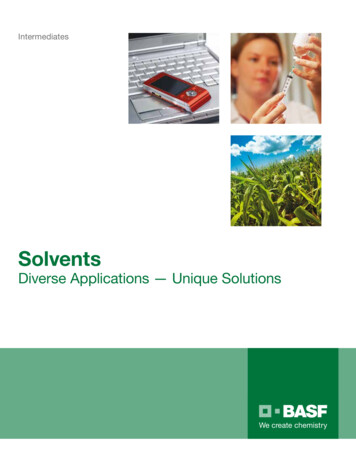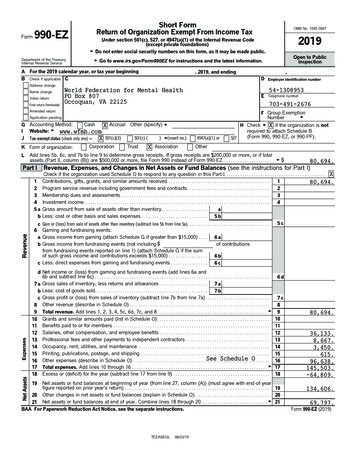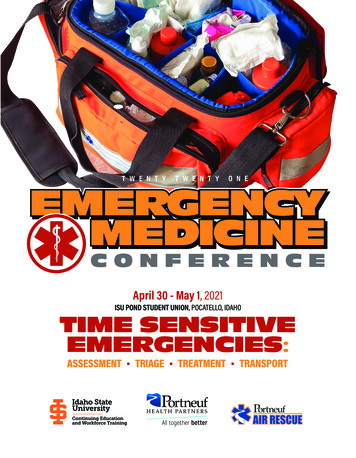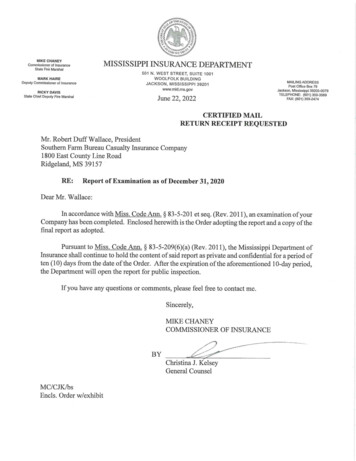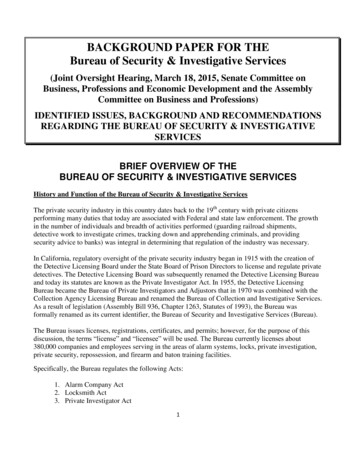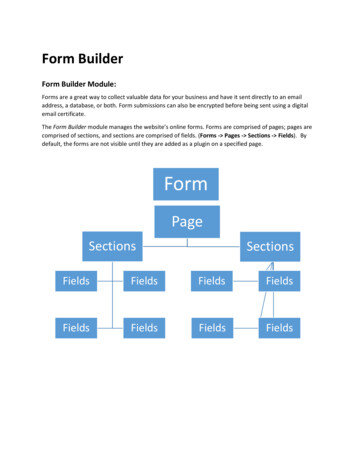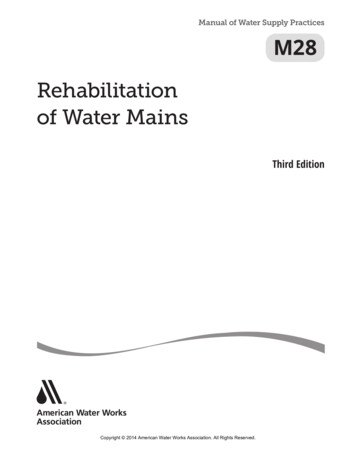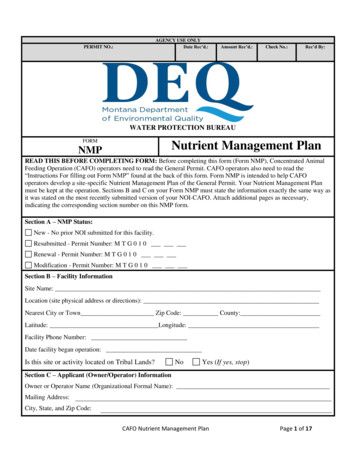
Transcription
AGENCY USE ONLYDate Rec’d.:PERMIT NO.:Amount Rec’d.:Check No.:Rec’d By:WATER PROTECTION BUREAUFORMNutrient Management PlanNMPREAD THIS BEFORE COMPLETING FORM: Before completing this form (Form NMP), Concentrated AnimalFeeding Operation (CAFO) operators need to read the General Permit. CAFO operators also need to read the“Instructions For filling out Form NMP” found at the back of this form. Form NMP is intended to help CAFOoperators develop a site-specific Nutrient Management Plan of the General Permit. Your Nutrient Management Planmust be kept at the operation. Sections B and C on your Form NMP must state the information exactly the same way asit was stated on the most recently submitted version of your NOI-CAFO. Attach additional pages as necessary,indicating the corresponding section number on this NMP form.Section A – NMP Status:New - No prior NOI submitted for this facility.Resubmitted - Permit Number: M T G 0 1 0Renewal - Permit Number: M T G 0 1 0Modification - Permit Number: M T G 0 1 0Section B – Facility InformationSite Name:Location (site physical address or directions):Nearest City or Town Zip Code: County:Latitude: Longitude:Facility Phone Number:Date facility began operation:Is this site or activity located on Tribal Lands?NoYes (If yes, stop)Section C – Applicant (Owner/Operator) InformationOwner or Operator Name (Organizational Formal Name):Mailing Address:City, State, and Zip Code:CAFO Nutrient Management PlanPage 1 of 17
Contact Name:Phone Number: ()Is the above the owner of the facility ?NoTitle:Email Address:YesSection D – NMP Minimum Elements:Attach aerial map of the production area that shows the locations of all structures included in the following 8 items.Please name each item and show the flow direction of storm water and waste water on the map. Please see exampleattached.1. Operation and Maintenancea. Livestock statistics and manure, litter and processed wastewater.Animal TypeMaximumNumberofanimals# ofDays onSite(peryear)Annual Manure litter and process wastewater productionDry in TonsLiquid in Gallons1.2.3.4.5.6.7.8.Method(s) used for estimating annual manure, litter and process wastewater production:b. Manure, litter and process wastewater handlingi. Identify manure, litter and process wastewater handling at the facility: Mark all that applyStored in pensStored on stacking padComposting on siteDirect pipe to liquid impoundmentStored in under floor pitSeparatorOtherii. Frequency of Manure Removal from confinement areas:Bi AnnuallyAnnuallyAs neededOtheriii. Is this manure, litter or process wastewater temporarily stored in any location other than theproduction area?YesNoIf so then how and where?CAFO Nutrient Management PlanPage 2 of 17
iv. Is dry manure and/or litter stored on impervious surface?YesNoIf yes, describe type and characteristics of this surface:c. Waste control structuresi. What is the 24hr.-25yr. storm event at your facility? Please refer to map(s) attached toapplication package. in/hr.ii. What is annual precipitation during critical winter storage period (180 days from mid-Octoberto mid-April) in.iii. Area with in clean water diversions: acres.Type of surfaces within clean water diversions area:Dirt acres or ft2Concrete acres or ft2Paved acresUnder roof acres or ft2 (if runoff is not part of clean water BMPs)Gravel acres or ft2Pasture acres or ft2Other acres or ft2Productionarea ft.)Depth(ft.)*Volumein gal.forliquidand ft3 ifdryNumberof daysofstorageWinterstoragedepthThe24hr.25 yr.stormeventdepth1.2.3.4.5.6.7.8.9.10.11.12.*At minimum 1 foot of free board must be maintained on liquid storage structuresCAFO Nutrient Management PlanPage 3 of 17
2. Mortality Managementa. Please check the box that describe how mortalities are disposed of at this facility.BurialCompostedIncinerationLand fillContractor removalOtherb. Describe the location where mortalities are disposed of, if part of production area.3. Clean Water Diversion Practices.Please check all that apply for how clean water is diverted from production area.DitchesEarthen bermsCulvertsSite gradingGutters and spoutsOther4. Prohibiting Animals and Wastes from Contact with State Waters.Please check all that apply for how animals and wastes are prohibited from direct contact with state waters:FencingWallInside buildingOther5. Chemicals and Contaminates. List all major chemicals or other contaminants handled on site aspart of your CAFO operation. This would include, but not limited to, pesticides, herbicides, animaldips, disinfectants, etc. Specify the method of disposal and location stored (on map required above)for each chemical/contaminant:CAFO Nutrient Management PlanPage 4 of 17
6. Conservation Practices:Check all temporary, permanent and structural BMPS which will be used to control runoff of pollutants fromfacility’s production area and include them on the map described above. If BMPS are not installed, include aschedule for implementation of each of these measures which may include details and specifications tosupplement their description(s).DitchesEarthen bermsCulverts and pipesSite gradingGutters and spoutsCovered PensBuffersOther7. Manure, Litter, Process Wastewater and Soil Sampling and Analysis Procedures:A representative manure, litter and process wastewater sample will be analyzed a minimum of onceannually for Total Nitrogen and Total Phosphorus. Analysis results should be reported in lbs/ton or lbs/1,000gal. Results of these analyses will be used in determining rates for manure, litter, and process wastewater andcopies for transfers.Sample collection will occur according to CAFO General Permit Appendix D.Other (describe)8. Land Application:Will manure be land applied to land either owned, rented, or leased by the owner or operator of the facility?Yes. Complete the information required for the narrative or linear approach to calculating the rate of landapplication of manure, litter and process wastewater (see explanation below).No. Explain how animal waste will be managed by the operation, including protocol for transfers ofmanure, litter and process wastewater.a. Photos and/or Maps Attach an aerial photograph or map of the site where manure is to be applied.(Use multiple photos/maps if necessary to show required details.) The photo(s)/map(s) must clearlyidentify the following items: Individual field boundaries for all planned land application areas A name, number, letter or other means of identifying each individual land application field. The soil type(s) present and their locations within the individual land application field(s). The location of any downgradient surface waters. The specific manure/waste handling or nutrient management restrictions associated with eachland application field i.e. setbacks. The location of buffers and setbacks around state surface waters, well heads, etc. The location of any downgradient open tile line intake structures The location of any downgradient sinkholes The location of any downgradient agricultural well heads The location of all conduits to surface watersCAFO Nutrient Management PlanPage 5 of 17
Check here if the maps attached to the NMP for the 2013 CAFO General Permit are still applicableand the Department should attach them to this NMP. If the maps are still applicable, new maps do notneed to be provided to the Department. (renewals only)b. Protocols to land apply manure, litter or process wastewater Check all temporary, permanent andstructural BMPS which will be used to control runoff of pollutants from facility’s land applicationarea. Indicate the location of these practices on the aerial photographs require. If not already in use,include a schedule for implementation of each of these measures. Attached details and specificationsmay be used to supplement this description.BuffersConstructed WetlandsInfiltration FieldSetbacksConservation TillageGrass FilterResidue ManagementTerraceOtherc. Soil Phosphorus Sampling and Analysis: Representative soil (composite) samples from the top 6inches layer of soil for each field where manure will be applied must be analyzed for phosphoruscontent at least once every three years. Analyses will be conducted by a qualified laboratory, using theOlsen P test. Results will be reported in parts per million (ppm) and will be used in determiningapplication rates for manure, litter, and process wastewater.Sample collection will occur according to Appendix D.Other (describe)d. Soil Nitrogen Sampling and Analysis: Representative soil (composite) samples must be must becollected from a depth of zero to six inches below the surface and analyzed for total nitrogen (as N) andnitrate (as N). A second composite sample must be collected at a depth of six to 24 inches and analyzedfor nitrate (as N) only. Samples must be analyzed in accordance with method code 4H2a1-3 in NRCSSoil Survey Laboratory Methods Manual, Soil Survey Investigations Report No. 42. Results must bereported as mg/kg total nitrogen and pounds per acre and will be used in determining application ratesfor manure, litter, and process wastewater.Sample collection will occur according to Appendix DOther (describe)e. The applicant has 2 ways in which to report how manure or process wastewater application rates can bereported to DEQ.i. Linear Approach. Expresses rates of application as pounds of nitrogen and phosphorus. CAFOsselecting the linear approach to address rates of application must include in the NMP submitted tothe Department the following information for each crop, field, and year covered by the NMP:1. The maximum application rate (pounds/acre/year of nitrogen and phosphorus) from manure,litter, and process wastewater.2. The outcome of the field-specific assessment of the potential for phosphorus transport from eachfield. The Department does not have an N transport risk assessment, therefore the NMP mustdocument any basis for assuming that nitrogen will be fully used by crops. The CAFO mustspecify any conservation practices used in calculating the risk rating.CAFO Nutrient Management PlanPage 6 of 17
3. The crops to be planted or any other uses of a field such as pasture or fallow fields.4. The realistic annual yield goal for each crop or use identified for each field.5. The nitrogen and phosphorus recommendations from Department acceptable sources for eachcrop or use identified for each field.6. Credits for all residual nitrogen in each field that will be plant-available.7. Consideration of multi-year phosphorus application. For any field where nutrients are applied ata rate based on the crop phosphorus requirement, the NMP must account for single-year nutrientapplications that supply more than the crop’s annual phosphorus requirement.8. All other additions of plant available nitrogen and phosphorus (i.e., from sources other thanmanure, litter, or process wastewater or credits for residual nitrogen).9. The form and source of manure, litter, and process wastewater to be land-applied.10. The timing and method of land application. The NMP also must include storage capacitiesneeded to ensure adequate storage that accommodates the timing indicated.11. The methodology that will be used to account for the amount of nitrogen and phosphorus in themanure, litter, and wastewater to be applied.12. Any other factors necessary to determine the maximum application rate identified in accordancewith this Linear Approach.13. For the Linear Approach the permittee will complete the Nutrient Budget Worksheet, attached,for the crop grown on each field for each year to which manure or process waste water is or maybe applied. A copy of each Nutrient Budget Worksheet will be maintained on site, and a copywill be submitted to the Departmentii. Narrative Approach. Expresses a narrative rate of application that results in the amount, in tons orgallons, of manure, litter, and process wastewater to be land applied. CAFOs selecting the narrativerate approach to address rates of application must include in the NMP submitted to the Departmentthe following information for each crop, field, and year covered by the NMP:1. The maximum amounts of nitrogen and phosphorus that will be derived from all sources ofnutrients (pounds/acre for each crop and field).2. The outcome of the field-specific assessment of the potential for nitrogen and phosphorustransport from each field. The Department does not have an N transport risk assessment,therefore the NMP must document any basis for assuming that nitrogen will be fully used bycrops. The CAFO must specify any conservation practices used in calculating the risk rating.3. The crops to be planted in each field or any other uses of a field such as pasture or fallow fields,including alternative crops if applicable. Any alternative crops included in the NMP must belisted by field, in addition to the crops identified in the planned crop rotation for that field.4. The realistic annual yield goal for each crop or use identified for each field for each year,including any alternative crops identified.5. The nitrogen and phosphorus recommendations from Department acceptable sources for eachcrop or use identified for each field, including any alternative crops identified.6. The methodology (including formulas, sources of data, protocols for making determination, etc.)and actual data that will be used to account for: (1) the results of soil tests, (2) credits for allnitrogen in the field that will be plant-available, (3) the amount of nitrogen and phosphorus in themanure, litter, and process wastewater to be applied, (4) consideration of multi-year phosphorusapplication (for any field where nutrients are applied at a rate based on the crop phosphorusrequirement, the methodology must account for single-year nutrient applications that supplymore than the crop’s annual phosphorus requirement), (5) all other additions of plant availablenitrogen and phosphorus to the field (i.e., from sources other than manure, litter, or processwastewater or credits for residual nitrogen), (6) timing and method of land application, and (7)volatilization of nitrogen and mineralization of organic nitrogen.7. Any other factors necessary to determine the amounts of nitrogen and phosphorus to be appliedin accordance with the Narrative Rate Approach.8. NMPs using the Narrative Rate Approach must also include the following projections, which willnot be used by the permitting authority in establishing site-specific permit terms: Planned crop rotations for each field for the period of permit coverage.CAFO Nutrient Management PlanPage 7 of 17
f.Projected amount of manure, litter, or process wastewater to be applied.Projected credits for all nitrogen in the field that will be plant-available.Consideration of multi-year phosphorus application.Accounting for other additions of plant-available nitrogen and phosphorus to the field.The predicted form, source, and method of application of manure, litter, and processwastewater for each crop.Phosphorus Risk Assessment: The permittee shall access the risk of phosphorus contamination of statewaters. An assessment shall be conducted for each field, under the control of the operator, to whichmanure, litter or process wastewater will or may be applied. If a new field is added in the future, then thepermittee must submit a revised (modified) NMP. The permittee has the option of using Method A orMethod B (below) to complete the assessment, unless the receiving water is impaired for nutrients, thenyou must use method B below for phosphorus risk assessment. Copies of all tables and calculations used tocomplete the assessments, as well as the results of the assessments, shall be submitted to the Departmentand copies shall be maintained onsite at the facility and available for Departmental review. The results ofthe assessments shall be used to determine the appropriate basis for land application of wastes from thefacility.Method UsedIndicate which method will be used to determine phosphorus application:i. Method A – Representative Soil Sampleii. Method B – Phosphorus IndexMethod A – Representative Soil SampleObtain one or more representative soil sample(s) from the field.Have the sample analyzed for Phosphorus by a qualified lab. The “Olsen P test” must be used for the analysis,and the result must be reported in parts per million (ppm)Using the results of the Olsen P test, determine application basis according to the Table below.Soil TestOlsen P Soil Test Results (ppm) 25.025.1 - 100.0100.0 – 150.0 150.0Application BasisNitrogen Needs of CropPhosphorus Needs of CropPhosphorus Needs up to Crop Removal RateNo Application allowedMethod B – Phosphorus IndexComplete a phosphorus Index according to the crop grown on each field. Complete table in Appendix A of thisNMP form to calculate phosphorus index. For information on filling out specific sections in Appendix A ofthis NMP form, please refer to the method as described in NRCS Agronomy Technical Note MT-77. Usingthe calculated Total Phosphorus Index Value, assign the overall site/field vulnerability to phosphorus lossaccording to the table below.Total PhosphorusTotal Phosphorus Index Value 1111-2122-43 43Site Vulnerability to Phosphorus LossLowMediumHighVery HighUsing the calculated Site Vulnerability to Phosphorus Loss, determine the appropriate application basisaccording to the table below.CAFO Nutrient Management PlanPage 8 of 17
Site Vulnerability to Phosphorus LossLowMediumHighVery HighApplication BasisNitrogen NeedsNitrogen NeedsPhosphorus Need Up to Crop RemovalPhosphorus Crop Removal or No Applicationg. Land Application Equipment CalibrationDescribe the type of equipment used to land apply wastes and the calibration procedures:9. Implementation, Operation, Maintenance and RecordkeepingThe permittee is required to develop protocols for implementation of NMP, proper operation and maintenanceof the livestock waste control facilities, and recordkeeping as described in Part 2 of the permit.a. Have protocols been developed for the operation?YesNob. The documents below are maintained:i. Implementation of the NMP:ii. Facility operation and maintenance:iii. Recordkeeping and reportingiv. Sample collection and analysisv. Manure transferYesYesYesYesYesNoNoNoNoNoc. If your answer to any of the above question is no, provide explanation:d. Provide date and location of most recent documentation:Section E - CERTIFICATIONPermittee Information: This form must be completed, signed, and certified as follows: For a corporation, by a principal officer of at least the level of vice president; For a partnership or sole proprietorship, by a general partner or the proprietor, respectively; or For a municipality, state, federal, or other public facility, by either a principal executive officer or ranking electedofficial.CAFO Nutrient Management PlanPage 9 of 17
All Permittees Must Complete the Following Certification:I certify under penalty of law that this document and all attachments were prepared under my direction or supervision inaccordance with a system designed to assure that qualified personnel properly gather and evaluate the informationsubmitted. Based on my inquiry of the persons who manage the system, or those persons directly responsible forgathering the information, the information submitted is, to the best of my knowledge and belief, true, accurate, andcomplete. I am aware that there are significant penalties for submitting false information; including the possibility offine and imprisonment for knowing violations.A. Name (Type or Print)B. Title (Type or Print)C. Phone No.D. SignatureE. Date SignedThe Department will not process this form until all of the requested information is supplied, and the appropriate feesare paid. Return this form and the applicable fee to:Department of Environmental QualityWater Protection BureauPO Box 200901Helena, MT 59620-0901(406) 444-5546CAFO Nutrient Management PlanPage 10 of 17
INSTRUCTION FOR Form NMP – Nutrient Management Plan AssociatedWith Concentrated Animal Feeding OperationsYou may need the following items in order to complete this form: A copy of your most recently submitted NOICAFO: NRCS No. 80.1 Nutrient Management, Agronomy Technical Note MT-11; Montana State UniversityExtension Service Publication 161, Fertilizer Guidelines for Montana Crops; NRCS Sampling Soils for NutrientManagement – Manure Resource, MT; Montana State University Mont Guide, Interpretation of Soil TestReports for Agriculture, MT200702AG; NRCS Conservation Practice Standard, Code 590 and WasteUtilization, Code 633.Please type or print legibly; forms that are not legible will be considered incomplete.SPECIFIC ITEM INSTRUCTIONSSection A – NMP Status:Check the box that applies and provide the requested information. If Form NMP has not been previously submitted forthis site, check the first box (New). DEQ will assign a permit number when the form is submitted. The permit number is a9-digit code beginning with MTG010. If you submitted a Form NMP and DEQ deemed the application deficient orincomplete, check the second box (Resubmitted); If you were notified by DEQ that the permit coverage expired or willexpire and you are now submitting a NMP to continue coverage check the third box (Renewal); if there is change in thefacility information, check the last box (Modification). If a NMP has been submitted and deemed deficient then thepermit number will appear in the deficiency letter. If the site has been covered under a CAFO General Permit, the numberis given on the authorization letter sent to you by DEQ. The permit number should be included on any correspondencewith DEQ regarding this site.Section B – Facility Information:Identify the legal name of the facility that is subject to permit coverage. The facility is the land or property where thefacility or activity is physically located or conducted, including adjacent land used in connection with the facility oractivity. Give the address or location of this facility and the geographical information. The location maybe the physicalmailing address or description of how the facility may be accessed. (PO Boxes are not acceptable.) Latitude and longitudemust be accurate to the nearest decimal degree. Sources include GPS or a USGS topographic map. If an operation islocated on tribal lands, the operation is not eligible for the Montana CAFO General Permit, but may be able to obtain apermit from the EPA or tribes.Section C – Applicant (Owner/Operator) Information:Give the name, as it is legally referred to, of the person, business, public organization, or other entity that owns, operates,controls or supervises the facility described in Section B of this Form. The operator is the legal entity which controls thefacility operation. The permit will be issued to the entity identified in this section (Section C). The owner or operatorassumes all liability for discharges of the facility and compliance with the permit. If the owner or operator is anythingother than a person or government entity, it must be registered with the Montana Secretary of State’s office.Section D – NMP Minimum Elements:1. Operation and Maintenancea. Livestock Statistics and manure, litter and processed wastewater: Identify each type of animal confinedat this facility. The definition of “type” could include animals of a given species, animals of a givenCAFO Nutrient Management PlanPage 11 of 17
weight class (e.g. piglets, sows), or animals housed for a specific purpose. The Animal types should beidentical to what is reported on the NOI.Enter the Maximum number of that type on animal that the facility can hold.Enter the “number of days on site per year” means the number of days at least one animal of a given typeis held in confinement during 12-month period.“Annual manure litter and process wastewater production” means the volume of manure, liter or processwastewater (from a given animal type) that is stored, land applied, or transferred to another person duringany given 12-month period.“Method(s) used for estimating annual manure, litter and process wastewater production.” Whendescribing the method used to calculate annual manure production, include all formulas, factors,references to tables, and other resources used to calculate manure production. Be sure to account forsoiled bedding materials.b. Manure, Litter and Process Wastewater handling.Identify where the manure, litter and process wastewater is handled and stored at the facility. Identify thefrequency that manure, litter or wastewater is removed from the confinement area. If the manure, litter orprocess wastewater is temporarily stored outside of the production area, please describe how and where.If dry manure or liter is stored on an impervious surface like concrete or asphalt, please describe.c. Waste Control Structures.“25-year 24-hour rainfall event” means a precipitation event with a probable recurrence interval of oncein 25 years as defined by the National Weather Service in Technical Paper Number 40, “RainfallFrequency Atlas of the United States,” May 1961, and subsequent amendments, or the equivalent regionalor state rainfall probability information.“Critical Storage period” The minimum design volume for liquid manure storage structures is based onthe expected length of time between emptying events that result in maximum production of processwastewater, including runoff from the production area. The critical storage period is considered to the 180days starting November 1st to April 30.List the area within the clean water diversions. This is the area that is inside the BMPs used for cleanwater diversions. This area is used to calculate the volume required to hold the 24hr.-25yr. storm eventand the volume of your critical storage period. Check all the surface types within the clean waterdiversion area in acre or ft2.List all waste control facilities for the production area. These may include, but are not limited to, manurelagoons, manure ponds, evaporation ponds, wastewater retention ponds, contaminated runoff retentionponds, settling basins, underground storage tanks, underfloor pits, manure solids stacking pads, vegetativetreatment strips, composting facilities, and dry stack facilities. Berms, dikes, concrete curbs, ditches, andwaste transfer pipelines are also waste control structures and must be listed, though some of the requestedmeasurements may not apply.2. Mortality Management. Please check the box(s) of how the facility manages their dead loss. Please describe thelocation where dead loss is disposed of if part of production area. The dead loss disposal area may be locatedoffsite.CAFO Nutrient Management PlanPage 12 of 17
3. Clean Water Diversion Practices. Please check all boxes supplied and include them on the required map of theproduction area.4. Prohibiting Animals from Contact with State Waters. Indicate what BMPs are used to prevent animals fromcoming into direct contact with waterbodies.5. Chemicals and Contaminants. List all major chemicals or other contaminants handled onsite as part of theCAFO operation. This would include, but not limited to, pesticides, herbicides, animal dips, disinfectants, etc.Specify the method of disposal for each chemical/contaminant.6. Conservation Practices. Check all BMPs that apply. These BMPs are used to control runoff of pollutants fromthe production area. Please note that “production area” means that part of a CAFO that includes the animalconfinement area, the manure storage area, the raw materials storage area, and the waste containment areas. The“animal confinement area” includes but in not limited to open lots, housed lots, feedlots, confinement houses, stallbarns, animal walkways, and stables. The “manure storage area” includes but is not limited to lagoons, runoffponds, storage sheds, stockpiles, under house or pit storages, liquid impoundments, static piles, and compostingpiles. The “raw material storage area” includes but is not limited to feed silos, silage bunkers, and beddingmaterials. The “waste containment area” includes but is not limited to settling basins, and areas within berms anddiversions which separate uncontaminated storm water. Also included in the definition of production area is anyegg washing or egg processing facility, and any area used in the storage, handling, treatment, or disposal ofmortalities.7. Manure, Litter and Process Wastewater Sampling and Analysis Procedures. Sampling and Analysis can bedone according to Appendix D of the CAFO General Permit8. Land Application: If all of the manure produced at your facility will be transferred to other persons for use inareas beyond your operational control, then you do not need to provide the information requested in followingsection.a. Photos and/or maps:Items that must be on the photo/map include buffers and setbacks around state surface waters, well heads,etc. The items required that are not already shown on published map(s) can be hand drawn on the map.b. Conservation Practices for land application: Check all BMPs that apply. These BMPs are used to controlrunoff of pollutants from the production area. Describe in detail all temporary, permanent and structuralBMPs which will be used to control runoff of pollutants from facility’s land production area. Indicate thelocation of these practices on the field maps required above. If not already in use, include a schedule forimplementation of each of these measures. Attached details and specifications may be used to supplementthis description. Examples of BMP measures could include but are not limited to: maintaining setbacksfrom surface waters for manure applications; managing irrigation practices to prevent ponding ofwastewater on land application sites; and consulting with the Department prior t
13. For the Linear Approach the permittee will complete the Nutrient Budget Worksheet, attached, for the crop grown on each field for each year to which manure or process waste water is or may be applied. A copy of each Nutrient Budget Worksheet will be maintained on site, and a copy will be submitted to the Department ii. Narrative Approach.
